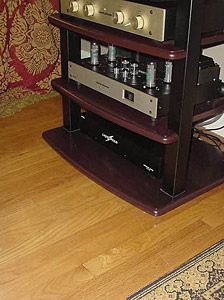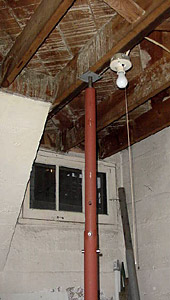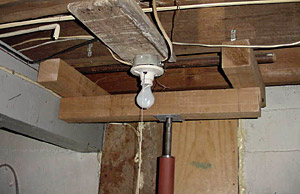![[SoundStage!]](../sslogo3.gif) Audio Hell Audio HellBack Issue Article |
July 2001 Floorquakes and other Hardwood Seismic Events Sometimes you really do need to forget about the trees and examine the forest. The other day I was on my way to my favorite vinyl establishment. Located in a part of town chock full of cultural, aesthetic, and social diversity, it is also a top-notch place for people-watching. As I walked along the sidewalk, I came upon an extensively pierced, magenta-haired youth closely examining the front fender of what could be labeled none other than a "real piecer." This is short for a real piece of…you get the picture. Apparently someone had run a key across the front of his fender, leaving a small scratch. How he could tell this I have no idea. The front window was cracked in several directions. Mirrors looked to have been missing for a decade or so. The tires were unfamiliar with the concept of tread. And every inch of the car's body was dented, scratched or rusted. Still, the youth was vexed by the new defect. He had other problems, larger fish to fry. Great blue whales compared to this guppy. Now don’t get all politically correct on me. I love whales. I give generously to Greenpeace. And besides, whales aren’t even fish. You get the point. It was with this in mind that I walked into my
living/listening room and entered into a slight paradigm shift. A Then it hit me (ouch). It wasn’t me at all -- thank God, and supersize those fries. It was my blasted floor. Eighty-year-old bungalow. Beautiful hardwood floors. Thirteen feet between pillars supporting the floor joists. Nailed oak planks (no screws) for underlayment. A regular hardwood trampoline sending waves of macro proportions across my listening room. The clomping wasn’t anything new. I was just noticing. The forest…I see the forest. I had been looking at the trees for years. The trees of which my semi-lucid ramblings have been referring are the various methodologies I had been using to address all those vibrations, resonances, couplings, and decouplings we all lose so much sleep (and money) over. Who can sleep with all that vibrating and coupling going on? Ooo, baby. Perhaps some of these tweak companies should look to a certain herbal shampoo company for their next ad campaign ideas. Balls, cups, spikes, pucks. Sounds like Joe Jockstrap’s gym locker is mighty full. Cones, blocks, squares. Time to clean up your toys junior. Bearings, pads, points. A good mechanic is hard to find. Pods, footers, feet. The podiatrist is definitely not in. I never fully realized how many products of this type are available to us diseased audiogeeks. All these cool little widgets for ridding our systems of a plague of micro-resonances coming at us from the floor, the air, the walls, even the components themselves. What may be most amazing of all is that almost every one of them works, to one degree of another. But the whys, whats, hows, and wheres are for another column. The forest that I had been missing, or perhaps selectively ignoring, was my floor and the wavy-gravy movement that accompanies it. I began to notice that if I sat in my listening position and placed my feet on the floor, I could feel every footstep as someone moved across the floor. Even Max (you remember the audiophile cat, don't you?) could produce a small seismic event as he jumped from his perch. He hates those cheap vinyl reissues, and he is on Science Diet Light by the way. Anyway, if I could feel those vibrations through my well-i-sole-ated Rockport Pro-Walkers, then the various electronica couldn’t be too immune either. Wait a minute! Shoes as isolation devices! I love it! Nike Airs for your Ayre. Converse for your Conrad-Johnson. Doc Martins for your MartinLogans. Sandals for your Simaudio. Birkenstocks for your Bel Canto. Hey does Reebok still make The Pump? Imagine the possibilities. But neither shoes, nor cones, nor pucks, nor any "little miracle Zen anti-vibration isolation decoupler" was going to do anything to keep the giant tsunamis from crashing across my floor. A suggestion of filling in the basement with 15,000 cubic feet of concrete was met with more than slight resistance from my lovely wife. I guess it would make changing the furnace filters a little difficult. It was time to visit the temple -- the temple of solutions to everyday problems. A place where answers are stacked to the heavens like great walls. I’m talking about my local home-improvement store, of course. Praise be to hardware. I’ve always loved hardware stores. There seems to be something magical about them. As I walk down each aisle, I always believe that I can build literally anything and everything from the contents in one of these stores. Electron microscope? Go to aisles 6A, 12C, and the end of 23B. Nuclear submarine? Visit aisles 18C and 20A. I swear it’s the truth. With this in mind, I began cruising the aisles in search of my solution. I soon came upon a product that was supposed to eliminate squeaks in old hardwood floors. The device was rather small and consisted of two pieces of metal joined by a threaded rod. The idea was to screw one half into the underlayment and the other half to the floor joist. You then tighten the threaded rod, pulling the floor down to the joist. At first this seemed like just the ticket. Tighten those floors right up. But after a few moments of contemplation, I realized that the only thing this would really do was eliminate squeaks. To eliminate the trampoline effect going on in my living room, I had to stop the flexing of the floor joists themselves. And then I saw it. Just down the aisle stacked in piles five or six feet high. The oracle had come through for me again. "Yes, ladies and gentlemen, step right this
way. No pushing, no shoving -- there’s room for you all. Now tell me the truth folks.
Are you having trouble with springy floors? Are your guests bouncing up and down like
those gophers at the carnival game every time someone walks across the room? Well maybe not quite helicopters. What we are actually talking about here are floor joist jacks. They consist of a pair of heavy steel tubes, one being slightly smaller than the other. They adjust for height by sliding one inside of the other and locking in place via a pair of heavy iron pins. A heavy iron disc sits in the top of one of the posts and a heavy threaded rod screws into this disc. You simply adjust the post for height, set it under the desired joist, place the included metal plate on top of the threaded rod, and turn the threaded rod until the plate makes contact with the joist. Then tighten in small amounts of no more that a turn or two per week. It’s important to do this slowly so you don’t create a list of other problems. Even at a slow pace you do take the risk of cracked plaster or sticking doors. I did not run into these problems, but you’ve been warned. So how many do you buy? You could buy enough to place one every two feet on every joist of your listening room. That would really firm things up. It would also make for an interesting trip across the basement when the light bulb burns out or the circuit breaker trips. You may decide to buy a border collie and train it to run obstacle courses. It won’t make the same mistake twice. Ouch! Or you might decide to be a little more conservative and start with a three-pack of posts. This is what I did.
I repeated the same procedure for each speaker. Luck was with me in that I avoided any obstacles such as ductwork or plumbing. I’m sure you could work around such problems, but you may have to design a jig of slightly higher complexity. Now, after all this jackin’ around (pun definitely intended), how does the music sound? Did it make a difference or should I paint my poles a brass color and sell them to a really bad strip joint? Sorry girls, but these poles are keepers. The first thing I noticed was the bass. It was tighter, deeper and more plentiful. Now that’s what I call a solid foundation. The midrange and upper frequencies also seemed a little less homogenized, a little more precise. Imaging was more pinpoint. This was especially noticeable with chamber music and small-ensemble jazz. The instruments were easier to locate and seemed to have more space around them. Down sides? I couldn’t hear any. So if your listening room is suspended over a basement (hopefully unfinished), then take my advice: Forget about trying out more of those micro tweaks until you have the macro tweaks taken care of first. Pound for pound, these poles are the best tweak I’ve put into my system. In fact, I’m definitely not done yet. As cheap as these things are, I’m planning on buying several more and experimenting. Maybe I’ll try spreading them around the room to form a matrix, or perhaps doubling up in some locations. I’ll let you know. Until then…. ...Bill Brooks
|
|
![[SoundStage!]](../sslogo3.gif) All Contents All ContentsCopyright © 2001 SoundStage! All Rights Reserved |
 s I walked across the floor, my footsteps
seemed heavier than usual. Clomp. Clomp. Clomp. Guess I better cut back on the French
fries. Clomp. Clomp. Clomp. I know I took off those clogging shoes. Clomp. Clomp. Clomp. I
obviously skipped the ballet classes. Clomp. Clomp. Clomp.
s I walked across the floor, my footsteps
seemed heavier than usual. Clomp. Clomp. Clomp. Guess I better cut back on the French
fries. Clomp. Clomp. Clomp. I know I took off those clogging shoes. Clomp. Clomp. Clomp. I
obviously skipped the ballet classes. Clomp. Clomp. Clomp. Does every object in your room seem to
move about like it’s been animated by some spell? Well then today is your lucky day.
For the low price of only $12.95 each, the amazing Tel-O-Post will turn that nasty
springboard of a floor into an immovable platform fit for landing helicopters."
Does every object in your room seem to
move about like it’s been animated by some spell? Well then today is your lucky day.
For the low price of only $12.95 each, the amazing Tel-O-Post will turn that nasty
springboard of a floor into an immovable platform fit for landing helicopters." The first place I concentrated on was under the equipment rack. This was an easy
decision because it was visibly the most affected by hardwood seismic events. With a few
measurements, it was easy to find the location of the rack from below. I also decided it
might be best to spread out the pressure pushing up from below, rather than a single
point. To do this I built a jig from three pieces of four-by-four stock. This effectively
spread out the pressure to an area about two and a half feet long and spanning two joists.
With just the initial tightening of the post, I could see a visible decrease in movement
of the rack if I walked by it with heavy footsteps. A good start.
The first place I concentrated on was under the equipment rack. This was an easy
decision because it was visibly the most affected by hardwood seismic events. With a few
measurements, it was easy to find the location of the rack from below. I also decided it
might be best to spread out the pressure pushing up from below, rather than a single
point. To do this I built a jig from three pieces of four-by-four stock. This effectively
spread out the pressure to an area about two and a half feet long and spanning two joists.
With just the initial tightening of the post, I could see a visible decrease in movement
of the rack if I walked by it with heavy footsteps. A good start.